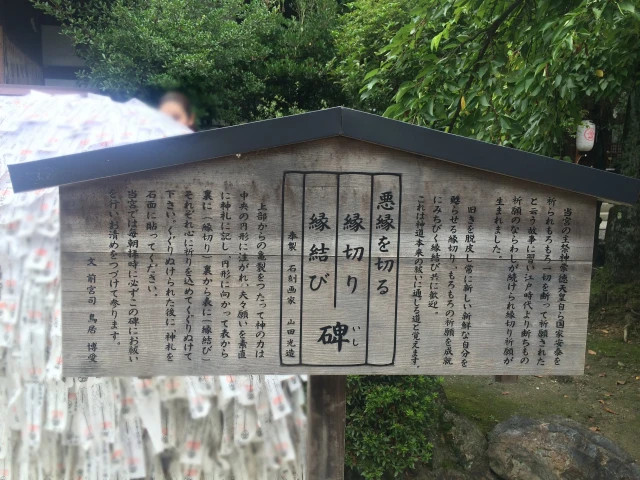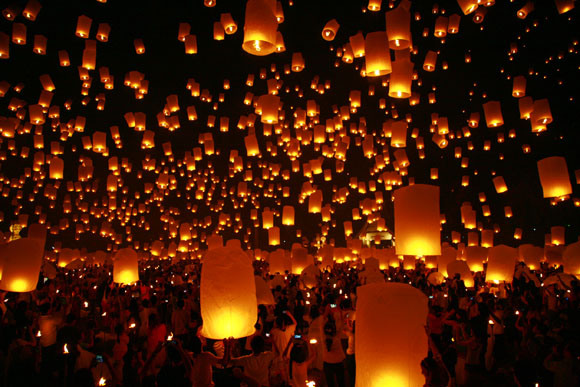Yasui Konpiragu worked its magic, but for once, not in the terrifying way it usually does.
wishes
This shrine has built up a reputation for granting wishes, but not in the way you want it to.
Held each year on July 7, the Tanabata festival has its roots in the folktale of a young married couple, symbolized by two stars in the night sky, who toil away at their trades separately, able to meet just once a year. It’s a little like the situation in many Japanese families where the husband gets transferred by his company to another prefecture and his wife stays behind to continue her own career or look after the kids. Just replace “office workers” with “cowherd and daughter of the king of heaven” and “prefectural border” with “the Milky Way,” and you’ve got a close approximation.
The story of the two lovers finally being able to see each other has taken on a broader connotation of wishes coming true, and Tanabata is commonly celebrated by writing a wish down on strip of paper, then tying it to a stalk of bamboo.
Department stores and shopping centers usually have displays where visitors post their wishes. Since they’re then on display for others to see, you can get a glimpse of current trends by checking them out. “My family’s safety,” “success in business,” and “health” are three old-standbys of Tanabata wishes, but what else were people hoping for this year?
Every year during the summer solstice, the night skies of Poland are filled with thousands of paper lanterns being released into the heavens. People write their wishes on the lanterns before sending them up into the sky in the hope that their wish will some day come true.
Yi Peng is a similar festival that takes place in Thailand, but instead of being used to make a wish, lanterns are used to symbolize the release of one’s troubles. It’s true that the customs and traditions surrounding these two festivals are different, but the sight of thousands of paper stars embracing the night sky is surely a universal beauty.



 Lacquerware supplier to emperor of Japan and Pokémon team up for new tableware
Lacquerware supplier to emperor of Japan and Pokémon team up for new tableware Japan may add Japanese language proficiency, lifestyle classes to permanent foreign resident requirements
Japan may add Japanese language proficiency, lifestyle classes to permanent foreign resident requirements Early-blooming sakura cherry blossoms create pink-tinged wonderlands in Japan
Early-blooming sakura cherry blossoms create pink-tinged wonderlands in Japan Mr. Sato attempts to battle his butt forest with Japan’s affordable Osu! Ass Hair Trimmer
Mr. Sato attempts to battle his butt forest with Japan’s affordable Osu! Ass Hair Trimmer Intimate Korean yoga workout promises to burn calories, get your heart racing【Video】
Intimate Korean yoga workout promises to burn calories, get your heart racing【Video】 I had no idea you could win crane game prizes in Japan the way my friend won this Dragon Quest Slime
I had no idea you could win crane game prizes in Japan the way my friend won this Dragon Quest Slime Dragon Quest Burgers and Slime drinks are coming to McDonald’s Japan【Video】
Dragon Quest Burgers and Slime drinks are coming to McDonald’s Japan【Video】 Studio Ghibli unleashes Turnip Head on the world
Studio Ghibli unleashes Turnip Head on the world Starbucks Japan releases new zodiac chilled cup drink for 2026
Starbucks Japan releases new zodiac chilled cup drink for 2026 We try cooking yakisoba with real Japanese buckwheat soba【SoraKitchen】
We try cooking yakisoba with real Japanese buckwheat soba【SoraKitchen】 7-Eleven Japan starts new temporary luggage storage service in over 300 branches
7-Eleven Japan starts new temporary luggage storage service in over 300 branches Starbucks teams up with 166-year-old Kyoto doll maker for Year of the Horse decorations【Photos】
Starbucks teams up with 166-year-old Kyoto doll maker for Year of the Horse decorations【Photos】 Disillusionment at Tsukiji’s tourist-target prices led us to a great ramen restaurant in Tokyo
Disillusionment at Tsukiji’s tourist-target prices led us to a great ramen restaurant in Tokyo Tokyo’s Tsukiji sushi neighborhood asks tour groups to stay away for the rest of the month
Tokyo’s Tsukiji sushi neighborhood asks tour groups to stay away for the rest of the month Street Fighter Hadouken Churros to be launched and eaten in Tokyo, Okami pudding on offer too
Street Fighter Hadouken Churros to be launched and eaten in Tokyo, Okami pudding on offer too Is this the most relaxing Starbucks in Japan?
Is this the most relaxing Starbucks in Japan? Starbucks on a Shinkansen bullet train platform: 6 tips for using the automated store in Japan
Starbucks on a Shinkansen bullet train platform: 6 tips for using the automated store in Japan Large amount of supposed human organs left in Osaka marketplace
Large amount of supposed human organs left in Osaka marketplace Japan’s human washing machines will go on sale to general public, demos to be held in Tokyo
Japan’s human washing machines will go on sale to general public, demos to be held in Tokyo Japanese train company is letting fans buy its actual ticket gates for their homes
Japanese train company is letting fans buy its actual ticket gates for their homes Tokyo considering law requiring more trash cans following litter increase in heavily touristed area
Tokyo considering law requiring more trash cans following litter increase in heavily touristed area Is China’s don’t-go-to-Japan warning affecting tourist crowds in Tokyo’s Asakusa neighborhood?
Is China’s don’t-go-to-Japan warning affecting tourist crowds in Tokyo’s Asakusa neighborhood? Nintendo’s Kirby now delivering orders at Kura Sushi restaurants, but not in Japan
Nintendo’s Kirby now delivering orders at Kura Sushi restaurants, but not in Japan Tokyo event lets you travel back in time, for free, to celebrate 100 years since Showa era start
Tokyo event lets you travel back in time, for free, to celebrate 100 years since Showa era start Survey asks foreign tourists what bothered them in Japan, more than half gave same answer
Survey asks foreign tourists what bothered them in Japan, more than half gave same answer Japan’s deadliest food claims more victims, but why do people keep eating it for New Year’s?
Japan’s deadliest food claims more victims, but why do people keep eating it for New Year’s? We deeply regret going into this tunnel on our walk in the mountains of Japan
We deeply regret going into this tunnel on our walk in the mountains of Japan Studio Ghibli releases Kodama forest spirits from Princess Mononoke to light up your home
Studio Ghibli releases Kodama forest spirits from Princess Mononoke to light up your home Major Japanese hotel chain says reservations via overseas booking sites may not be valid
Major Japanese hotel chain says reservations via overseas booking sites may not be valid Put sesame oil in your coffee? Japanese maker says it’s the best way to start your day【Taste test】
Put sesame oil in your coffee? Japanese maker says it’s the best way to start your day【Taste test】 The top 10 annoying foreign tourist behaviors on trains, as chosen by Japanese people【Survey】
The top 10 annoying foreign tourist behaviors on trains, as chosen by Japanese people【Survey】 No more using real katana for tourism activities, Japan’s National Police Agency says
No more using real katana for tourism activities, Japan’s National Police Agency says Starbucks Japan reveals new sakura drinkware collection, inspired by evening cherry blossoms
Starbucks Japan reveals new sakura drinkware collection, inspired by evening cherry blossoms I had no idea you could win crane game prizes in Japan the way my friend won this Dragon Quest Slime
I had no idea you could win crane game prizes in Japan the way my friend won this Dragon Quest Slime Dragon Quest Burgers and Slime drinks are coming to McDonald’s Japan【Video】
Dragon Quest Burgers and Slime drinks are coming to McDonald’s Japan【Video】 Studio Ghibli unleashes Turnip Head on the world
Studio Ghibli unleashes Turnip Head on the world Starbucks Japan releases new zodiac chilled cup drink for 2026
Starbucks Japan releases new zodiac chilled cup drink for 2026 We try cooking yakisoba with real Japanese buckwheat soba【SoraKitchen】
We try cooking yakisoba with real Japanese buckwheat soba【SoraKitchen】 Why you shouldn’t call this food “Hiroshimayaki” if you’re talking to people from Hiroshima
Why you shouldn’t call this food “Hiroshimayaki” if you’re talking to people from Hiroshima How to write “sakura” in Japanese (and why it’s written that way)
How to write “sakura” in Japanese (and why it’s written that way) Shizuoka senior charged with firearms violation after giving toy guns to the police
Shizuoka senior charged with firearms violation after giving toy guns to the police Proposed sakura name for new middle school in Japan draws complaints for kamikaze overlap
Proposed sakura name for new middle school in Japan draws complaints for kamikaze overlap